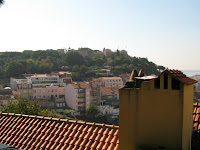 Been away, as I'm sure you can tell. To a country I've always wanted to go but never had the chance, Portugal. It was always, somehow, just too inconvenient to get to, being at the edge of Europe and all. And every previous trip to Europe centered around London, Nice & Vienna.
Been away, as I'm sure you can tell. To a country I've always wanted to go but never had the chance, Portugal. It was always, somehow, just too inconvenient to get to, being at the edge of Europe and all. And every previous trip to Europe centered around London, Nice & Vienna. But to a girl from Singapore, growing up propped at the tip of the Straits of Malacca, you hear stories of the Portuguese. Of Afonso de Albuquerque who captured Malacca, of how the seafaring Portuguese ruled Malacca as a trading port & emporium back in the 16th century and you'd also have many Eurasian friends descended
But to a girl from Singapore, growing up propped at the tip of the Straits of Malacca, you hear stories of the Portuguese. Of Afonso de Albuquerque who captured Malacca, of how the seafaring Portuguese ruled Malacca as a trading port & emporium back in the 16th century and you'd also have many Eurasian friends descended  from those early colonialist with surnames like De Souza, Thesiera, D' Almeda. Although Portugal was thousand of clicks away, it still felt unexpectedly familiar.
from those early colonialist with surnames like De Souza, Thesiera, D' Almeda. Although Portugal was thousand of clicks away, it still felt unexpectedly familiar. b & I only had 3 weeks for the land of the Lusitanians so we decided to concentrate on just the south: Alentejo, the Algarve and around Lisbon. No point mad-dashing through a host of towns spending only a day there with not much time t o soak up the atmosphere. No, we'd take a fairly relaxed route. Moving out from Lisbon eastward toward the medieval town of Marvao, perched on a high outcrop overlooking the dry plains of western Spain; then working our way southwards to Evora, with it's romantic Roman ruins, to Mertola where a languid river runs, then to the Algarve . Staring with a charming town called Tavira, staying in a converted Tuna factory, working westward toward the end of the world to a place called Sagres, then travelling up northward to coastal Alentejo and back to Lisbon having circled the south in 2 weeks.
b & I only had 3 weeks for the land of the Lusitanians so we decided to concentrate on just the south: Alentejo, the Algarve and around Lisbon. No point mad-dashing through a host of towns spending only a day there with not much time t o soak up the atmosphere. No, we'd take a fairly relaxed route. Moving out from Lisbon eastward toward the medieval town of Marvao, perched on a high outcrop overlooking the dry plains of western Spain; then working our way southwards to Evora, with it's romantic Roman ruins, to Mertola where a languid river runs, then to the Algarve . Staring with a charming town called Tavira, staying in a converted Tuna factory, working westward toward the end of the world to a place called Sagres, then travelling up northward to coastal Alentejo and back to Lisbon having circled the south in 2 weeks.But to spare you from a long-drawn tale of travel, I'll be splitting up the story into 3 parts.
This one will be about Lisbon, the place where there's so much to tell.
 I'll do the next post on the inland Alentejo pit-stops. Especially morbid was the Chapelle Dos Ossos, The Chapel of Bones, which was built with 5000 skeletons....freaky.
I'll do the next post on the inland Alentejo pit-stops. Especially morbid was the Chapelle Dos Ossos, The Chapel of Bones, which was built with 5000 skeletons....freaky.The final post should cover the meandering through coastal towns in the Algarve, Alentejo & around Lisbon.
 It's been a couple of years since I've been back to Europe and so it was Lisbon's Euro-ness that struck me. I couldn't keep my eyes off all the architectural intricacies, the millennia of history seeping out between the cobbled streets and the oh-so stylish cars zipping about the roads.
It's been a couple of years since I've been back to Europe and so it was Lisbon's Euro-ness that struck me. I couldn't keep my eyes off all the architectural intricacies, the millennia of history seeping out between the cobbled streets and the oh-so stylish cars zipping about the roads. Lisbon was all but demolished in the great earthquake of 1755, one of the worst earthquakes in history. The city was rebuilt by the then Prime Minister, the Marquis of Pombal, who was one of the first to build a city based on a grid road system. The buildings constructed during his rule were made earthquake proof. And this is in the 16th century! This was just one example of his futuristic thinking. He also built extra wide 3-laned roads in the time of horse & carriage.
Lisbon was all but demolished in the great earthquake of 1755, one of the worst earthquakes in history. The city was rebuilt by the then Prime Minister, the Marquis of Pombal, who was one of the first to build a city based on a grid road system. The buildings constructed during his rule were made earthquake proof. And this is in the 16th century! This was just one example of his futuristic thinking. He also built extra wide 3-laned roads in the time of horse & carriage.  When someone asked him why, he said that someday these roads would be small. And while drinking potent cafe pingado on a street side cafe and looking at the choc-a-bloc stream of cars chugging down Avenida Liberdade, I'd say Pombal must have had a crystal ball.
When someone asked him why, he said that someday these roads would be small. And while drinking potent cafe pingado on a street side cafe and looking at the choc-a-bloc stream of cars chugging down Avenida Liberdade, I'd say Pombal must have had a crystal ball. The city spreads over several hills and in the course of exploring the sights, there were tons of puffing up steep gradients.
The city spreads over several hills and in the course of exploring the sights, there were tons of puffing up steep gradients. Lisbon's ingenious solution to taking the pant out of hill climbing was to build elevators and trams, otheriwse known as funinculars, that ply slopes. Although most of the city folk don't use them anymore. More for the tourists like this girl.
Lisbon's ingenious solution to taking the pant out of hill climbing was to build elevators and trams, otheriwse known as funinculars, that ply slopes. Although most of the city folk don't use them anymore. More for the tourists like this girl. And like tourists we also took the other wooden tram to explore an area called Alfama. It was one of the precious parts of Lisbon not destroyed by the earthquake.
And like tourists we also took the other wooden tram to explore an area called Alfama. It was one of the precious parts of Lisbon not destroyed by the earthquake.In the 700;s when the Moors wrestled parts of southern Portugal away from the Visigoths and other Germanic tribes, Alfama made up the entire city of Lisbon.

 Today, though, it is a labyrinth of narrow & twisting streets. And that wooden tram ride through it is not for those of you with weak stomachs.
Today, though, it is a labyrinth of narrow & twisting streets. And that wooden tram ride through it is not for those of you with weak stomachs. On top of one of her hills is Castelo Sao Jorge. An expansive fortress castle with a commanding lookout over the river Tagus.
On top of one of her hills is Castelo Sao Jorge. An expansive fortress castle with a commanding lookout over the river Tagus.  It gave us one of our first overviews of the city. The replica of the Golden Gate bridge, the other hill Barrio Alto with it's destroyed Cammerlite church & lace steel street elevator, the large squares with statues and it's many green parks.
It gave us one of our first overviews of the city. The replica of the Golden Gate bridge, the other hill Barrio Alto with it's destroyed Cammerlite church & lace steel street elevator, the large squares with statues and it's many green parks. I think that one of the enjoyment of travelling is the unexpected that greets you when you turn around an unfamiliar corner. On the Thursday before we were to come back to Vancouver, on our way to lunch, we turned the corner that linked our hotel to Avenida Libradade. Sprinkled among the streams of people were many wearing garments of a particular green.
I think that one of the enjoyment of travelling is the unexpected that greets you when you turn around an unfamiliar corner. On the Thursday before we were to come back to Vancouver, on our way to lunch, we turned the corner that linked our hotel to Avenida Libradade. Sprinkled among the streams of people were many wearing garments of a particular green. 
As we walked toward the Rossio we started seeing more and more of these greenlings. How odd! Then rounding another corner we came face to face with an entire square of leprechaun green Celtic Football club supporters come to Lisbon for a game with Benfica, one of Lisbon's teams. It was such a happy festive
 atmosphere buzzing the city that day. Of anticipation and pride. So taken by the vibe were we that we actually made it to street cafe to watch the game. It was like world cup all over again! Magic!!
atmosphere buzzing the city that day. Of anticipation and pride. So taken by the vibe were we that we actually made it to street cafe to watch the game. It was like world cup all over again! Magic!!Sadly for the Celts, they lost. Suffice to say, there were many dark & depressed-looking fans in green the next day at breakfast lamenting the game.
 The other thrilling unexpected find was the little known & extremely vicious Attack Butterflies of Lisbon. So dangerous are they that they are locked up behind heavy steel doors in Lisbon's Natural History museum. A must see for all brave souls.
The other thrilling unexpected find was the little known & extremely vicious Attack Butterflies of Lisbon. So dangerous are they that they are locked up behind heavy steel doors in Lisbon's Natural History museum. A must see for all brave souls.Well, that's the bit for Lisbon. Will be posting the rest when I gather up enough steam.




1 comment:
sounds like you had a wonderful time. you've written it so well i almost feel like i've been there with you! xo
Post a Comment